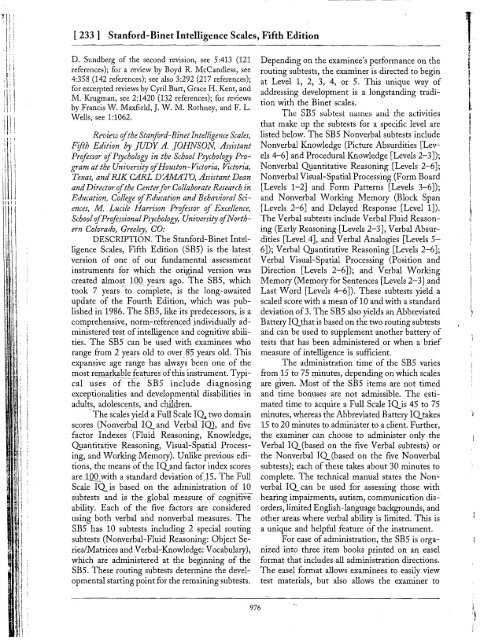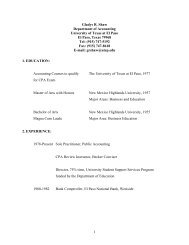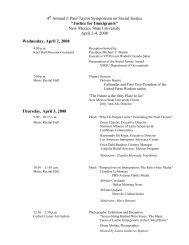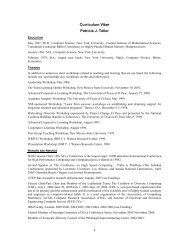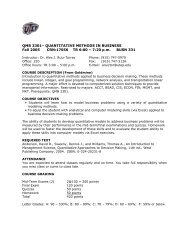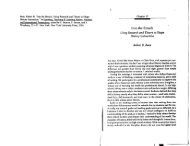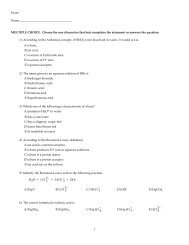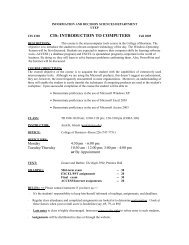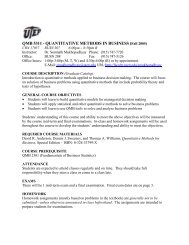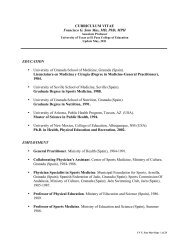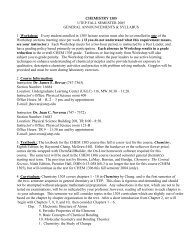Stanford-Binet Intelligence Scales, Fifth Edition ... - Faculty.utep.edu
Stanford-Binet Intelligence Scales, Fifth Edition ... - Faculty.utep.edu
Stanford-Binet Intelligence Scales, Fifth Edition ... - Faculty.utep.edu
Create successful ePaper yourself
Turn your PDF publications into a flip-book with our unique Google optimized e-Paper software.
'1, Ii.jI[233] <strong>Stanford</strong>-<strong>Binet</strong> <strong>Intelligence</strong> <strong>Scales</strong>, <strong>Fifth</strong> <strong>Edition</strong>references); for a review by Boyd R. McCandless, see4:358 (142 references); see also 3:292 (217 references);; I Ifor excerpted reviews by Cyril Burt, Grace H. Kent, andI D. Sundberg of the second revision, see 5:413 (121II I!IM. Krugman, see 2:1420 (132 references); for reviews:i by Francis W. Maxfield, J. W. M. Rothney, and F. L.Wells, see 1:1062.II!Review rfthe <strong>Stanford</strong>-<strong>Binet</strong> <strong>Intelligence</strong> <strong>Scales</strong>,<strong>Fifth</strong> <strong>Edition</strong> by JUDY A. JOHNSON, AssistantProfessor rfPsychology in the School Psychology Programat the University rfHouston-Victoria, Victoria,Texas, and RlK CARL D'AMATO, Assistant Deanand Director rfthe Centerfor Collaborate Research inEducation, College rfEducation and Behavioral Sciences,M. Lucile Hamson Professor rf Excellence,School rfProfessionalPsychology, University rfNorthernColorado, Greeley, CO:DESCRIPTION. The <strong>Stanford</strong>-<strong>Binet</strong> <strong>Intelligence</strong><strong>Scales</strong>, <strong>Fifth</strong> <strong>Edition</strong> (SB5) is the latestversion of one of our fundamental assessmentinstruments for which the original version wascreated almost 10Qyears ago. The SB5, whichtook 7 years -to com.plete, is the long-await<strong>edu</strong>pdate of the Fourth <strong>Edition</strong>, which was publishedin 1986. The SB5, like its predecessors, is acomprehensive, nOlm-refer~nc:edjndividually administeredtest ofintelligence and cognitive abilities.The SB5 can be used with examinees whorange from 2 years old to over 8?years old. Thisexpansive age range has always been one of themost rem::lr~2te.fe::a!Ures ofthis instrument. Typicaluses of the SB5 include diagnosjngexceptionalities and developmental disabilities inadults, adolesceilts, and c4iLdn~n.«The scales yield a Full Scale IQtwo domainscores (Nonverbal IQand Verbal' 102, and fivefactor Indexes «Fluid Reasoning, Knowledge,Qyantitative Reasoning, Visual-Spatial Processing,and Working Memory). Unlike previous editions,the means of the IQand factor index scoresare.JQO.with a standard deviation ofJ5. The FullScaleIQis based on the administration of 10subtests and is the global.measur~gf c9gplfiveability. Each of the five factors are consider<strong>edu</strong>sing both verbal and nonverbal measures. TheSB5 has 10 subtests including 2 special routingsubtests (Nonverbal-Fluid Reasoning: Object SerieslMatricesand Verbal-Knowledge: Vocabulary),which are administered at the beginning of theSB5. These routing subtests determine the developmentalstarting point for the remaining subtests.1Depending on the examinee's performance on therouting subtests, the examiner is directed to begin Iat Level 1, 2, 3, 4, or 5. This unique way of !addressing development is a longstanding tradiItion with the <strong>Binet</strong> scales.t.The SB5 subtt:st namt:::; and the activitiesthat make up the subtests for a specific level are ,listed below. The SB5 Nonverbal subtests includeNonverbal Knowledge (Picture Absurdities [Lev !els 4-6] and Proc<strong>edu</strong>ral Knowledge [Levels 2-3]); IINonverbal Qyantitative Reasoning [Levels 2-6];Nonverbal Visual-Spatial Processing (Form Board[Levels 1-2] and Form Patterns [Levels J-:-6]);and Nonverbal Working Memory (Block Span[Levels 2-6] and Delayed Response [Level 1]).The Verbal subtests include Verbal Fluid Reasoning(Early Reasoning [Levels 2-3J, Verbal Absurdities[Level 4], and Verbal Analogies [Levels 56]); Verbal Qyantitative Reasoning [Levels 2-6J;Verbal Visual-Spatial Processing (Position andDirection [Levels 2-6]); and Verbal WorkingMemory (Memory for Sentences [Levels 2-3] andLast Word [Levels 4-6]). These subtests yield ascaled score with a mean of10 and with a standarddeviation of3. The SB5 also yields an AbbreviatedBattery IQthat is based on the two routing subtestsand can be used to supplement another battery oftests that has been administered or when a briefmeasure of intelligence is sufficient.The administration time of the SB5 variesfrom 15 to 75.minutes, depending on which scalesare gIven. Most of the SB5 items are not timedand time bonuses are not admissible. The estimatedtime to acquire a Full Scale IQis 45 to 75minutes, whereas the Abbreviated Battery IQtakes15 to 20 minutes to administer to a client. Further,the examiner can choose to administer only theVerbal IQ(based on the five Verbal subtests) orthe Nonverbal IQ(based on the five Nonverbalsubtests); each of these takes about 30 minutes tocomplete. The technical manual states the NonverbalIQcan be used for assessing those withhearing impairments, autism, communication dis-'orders, limited English-language backgrounds, andother areas where verbal ability is limited. This isa unique and helpful feature of the instrument.For ease of administration, the SB5 is organizedinto three item books printed on an easelformat that includes all administration directions.The easel format allows examinees to easily viewtest materials, but also allows the examiner toi%I976


